Kadapa district
Kadapa district (officially: YSR district;[3] formerly: Cuddapah district[4]) is one of the twenty six districts in the Indian state of Andhra Pradesh. In 2022 reorganisation of Andhra Pradesh districts, the district boundary is largely restricted to Kadapa parliamentary constituency area. It is also one of the eight districts in the Rayalaseema region. Kadapa is the administrative headquarters for this district.[5]
Kadapa district | |
|---|---|
| YSR district | |
  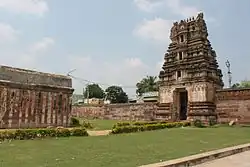  Clockwise from top-left: Kodanda Rama Temple in Vontimitta, Chennakeshava temple in Pushpagiri, Gandikota Fort temple, Hills in Sri Lankamalleswara Wildlife Sanctuary, Soumyanathaswamy Temple, Nandalur | |
| Nickname: Gadapa | |
.svg.png.webp) Location of YSR district in Andhra Pradesh | |
| Coordinates: 14.475°N 78.822°E | |
| Country | |
| State | |
| Region | Rayalaseema |
| Established | 1808 |
| 1st Reorganized | 1953 |
| 2nd Reorganized | 4th April 2022 |
| Named for | Y. S. Rajasekhara Reddy |
| Headquarters | Kadapa |
| Administrative Divisions | |
| Government | |
| • District collector | V. Vijay Ramaraju, IAS |
| • Lok Sabha | Lok Sabha list |
| • Assembly | Assembly list |
| Area | |
| • Total | 11,228 km2 (4,335 sq mi) |
| • Rank | 7th |
| Population (2011)[1] | |
| • Total | 2,060,654 |
| • Rank | 18th |
| • Density | 188/km2 (490/sq mi) |
| • Rank | 21st |
| • Urban | 809,290 |
| • Rural | 1,251,364 |
| • Households | 706,204 |
| • Sex ratio | 985 (females per 1,000 males) |
| Languages | |
| • Official | Telugu |
| Literacy | |
| • Literates | 1716766 |
| Time zone | UTC+5:30 (IST) |
| Postal Index Number | 516xxx |
| Area codes | +91–8562 |
| ISO 3166 code | IN-AP |
| Vehicle registration | AP-04 (former) AP–39 (from 30 January 2019)[2] |
| Website | kadapa |
Barytes, Lime Stone, Asbestos and Uranium are major mineral resources of the district. The district is home to many religious and historic places of interest. Kodandarama Temple at Vontimetta, Chennakesava temple of Pushpagiri, Siddavatam Fort and Gandikota gorge are some of the famous places.
Etymology
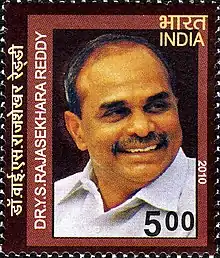
The old records of the district reveal that Kadapa was previously called Gadapa which translated in Telugu to threshold. The ancient village of Kadapa with its large tank and temple of Lord Venkateswara at Devuni Kadapa was convenient camping place for the myriads of pilgrims travelling to the holy shrine of Tirupati. On 19 August 2005, the nomenclature of “Cuddapah” had been changed to “Kadapa” by the Government of A.P. It was renamed as Y.S.R District during the year 2010, in honour of Y. S. Rajasekhara Reddy, the former chief minister of United Andhra Pradesh.[6]
History
This region was part of Maurya Empire, Satavahana dynasty, Chola dynasty, Pallava dynasty, Bana Kingdom, Rashtrakuta dynasty, Kakatiya dynasty, Vijayanagara Empire, Maratha Empire, Kingdom of Mysore and Carnatic Sultanate during the course of its history upto medieval period.[7] Later on it was ruled as part of British East India company.
Prehistory
Many paleolithic sites were found in Kadapa district, as the surroundings of Jammalamadugu, Mailavaram Dam[8] and Gandikota. Some megalithic burial sites were explored near Porumamilla, Sankhavaram and at Yellatur[9] village near Kadapa. The surroundings of Vontimitta are also noted as Megalithic cultural sites.
Paleolithic rock paintings found at Chintakunta caves[10] near Muddanur in Kadapa district are said to be the second largest group of paintings in India after Bhimbetika rock art paintings. The rock paintings with mystic figures are also found at Dappalle village[8] near Mylavaram Dam in Jammalamadugu Taluk of the district.
This region was ruled by the Mauryan Empire and the Satavahana Empire (Andhras).[11] Buddhism flourished for many years along the banks of the rivers Cheyyeru and Penna. Jainism also had a place in Kadapa district history; the remnants of a buried Jain temple were found at Danavulapadu[12] village on the banks of the Penna.
Medieval history
In the later half of 13th Century, this region was ruled from Vallur by Ambadeva. During his rule, the land survey was carried out. Subsequently, a Kakatiya King Pratapa rudra ruled the district with Warangal as the capital. Jyothi village located in Siddavatam mandal has 108 Shiva lingas on the bank of the river Penna which are dated to the rule of Kakatiyas.[13]
In A.D.1309, Allah-ud-din Khilji defeated PratapaRudra and took over the region.[14] In 1344, the confederation of Hindu kings overthrew the Muslim rule. This led to the formation of Vijayanagar Empire, who ruled the area for two centuries. Gandikota fort located on the bank of the Penna river was the citadel of Pemmasani Nayaks, commanders of Vijayanagar army. After the fall of Vijayanagar kingdom, this region came under the rule of Qutub shahis, who later became part of Mughal empire.
As part of Qutub Shahi rule, Riza Quli Beg under the title of Nek naam Khan and his successors ruled the region[15] with certain degree of autonomy. Later Abdul Nabi Khan was appointed as the governor of the district in the year 1714. The Marathas invaded and defeated the nawabs of Kurnool and Kadapa in 1740. Hyder Ali took over Gurramkonda and Kadapa from Marathas in 1760. He appointed his brother-in-law Mir Saheb in Kadapa district. Thus Mir Saheb became son first ruler of the district. This region was transferred to Nizam by the treaties of Mysore and Srirangapatnam.[14]
Modern history
Nizam of Hyderabad ceded it to the British in 1800, and in 1808 it was divided to form Kadapa (spelt Cuddapah by the British) and Bellary districts.[16] Munro was appointed as principal Collector over the ceded districts. Munro subjugated over 80 Palegars, instituted revenue collection system through which he secured the finances.[17] The district headquarters were situated in Siddavatam but moved to Kadapa in 1812.[18] On April 4th 2022, Annamayya district was formed from the parts of erstwhile YSR Kadapa district and others.
Demographics
As of 2011 census, Kadapa district has a population of 2,884,524.[19] This gives it a ranking of 132 in India (out of a total of 640). The district has a population density of 188 inhabitants per square kilometre (490/sq mi) . Its population growth rate over the decade 2001–2011 was 10.87%. It has a sex ratio of 984 females for every 1000 males, and a literacy rate of 67.88%.[19]
Economy
The Gross District Domestic Product (GDDP) of the district for FY 2013-14 is ₹26,342 crore (US$3.3 billion) and contributes 5% to the Gross State Domestic Product (GSDP). For the FY 2013–14, the per capita income at current prices was ₹70,821 (US$890). The primary, secondary and tertiary sectors of the district contribute ₹6,204 crore (US$780 million), ₹6,935 crore (US$870 million) and ₹13,203 crore (US$1.7 billion) respectively.[20]
Geography
Kadapa district occupies an area of 11,228 square kilometres (4,335 sq mi).[1] This district is bordered on north by Nandyal district, south by Annamayya district, east by SPS Nellore district and west by Sri Sathya Sai district and Anantapur district.[1]
The main rivers in this district are Penna, Kundu,Chitravathi, Papagni, and Sagileru.[21] Vellikonda, Palakonda, Nallamalai, Lankamalai and Yerramalai are the major hill ranges in the district.[22] The forests of Kadapa comprise fuel forests up to an elevation of 800 feet, red sanders lying between the elevation of 800 feet and 2,000 feet and Shorea Eugenia at elevations of more than 2,000 feet.[23]
Fauna
The Bonnet monkey (MacacaRadiata) also known as the Madras Langur is common. Tiger and Panther can be seen in the interior areas of Nallamalas, Lankamalas, Palakonda-Seshachalam and Velikonda forests. mungoose, jackal,fox, wolves, wild dogs, bear, the Malabar squirrel, porcupine, the Indian antelope, Indian gazelle, Blue bull, sambar, deer and wild pigs are also found in the forests. Grey partridge known as Kamju, the quail, the Jungle fowl, the dove, pigeon and wild goose are the other common birds found in this district.[23]
Soil
Red ferruginous and Black soils are common in the district. Fertile black clay soil occupies 23.7% area.[24]
Minerals
Barytes, Lime Stone and Asbestos are the major minerals. Napa slabs, road metal, building stone, marble, are also found in the district.[24] Limestone is available in Yerraguntla. National Mineral Development Corporation is extracting asbestos in Brahman palli and barytes in Mangampet. Kadapa is also famous for its stone called "kadapa stone" used in building construction and for slabs especially in south India. In Tummalapalle, there are 49,000 tonnes of confirmed uranium deposits which are mined and processed locally.[25][26]
Climate
The summer season is spread over March-May. This is followed by the South-West monsoon during June - September. North East monsoon season is spread over October-November. December-February is the winter or cold season. The average annual rainfall is 572.25 mm. The rainfall generally increases from the North-West to the South-East. October is the month with maximum rainfall. [24]
Demographics
After reorganization,the district had a population of 20,60,654, of which 809,290 (39.27%) lived in urban areas.[1] Kadapa district had a sex ratio of 985 females per 1000 males. Scheduled Castes and Scheduled Tribes make up 3,37,860 (16.40%) and 40,994 (1.99%) of the population respectively.[28] Hinduism is the dominant religion with 83.02% followers followed by Islam with 15.40% followers.
Based on the 2011 census, as computed for the revised district boundaries of 2022, 84.66% of the population spoke Telugu and 14.37% Urdu as their first language.[29]
Administrative divisions
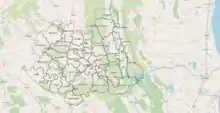
The district is divided into 4 revenue divisions: Badvel, Jammalamadugu, Kadapa and Pulivendula, which are further subdivided into a total of 36 mandals, each headed by a sub-collector.[30][31]
Mandals
The list of 36 mandals in YSR district, divided into 4 revenue divisions, is given below.
- Badvel revenue division
- Atlur
- B. Kodur
- Badvel
- Bramhamgari Matham
- Chapadu
- Duvvur
- Gopavaram
- Kalasapadu
- Khajipet
- Mydukur
- Porumamilla
- Sri Avadhutha Kasinayana
- Jammalamadugu revenue division
- Jammalamadugu
- Kondapuram
- Muddanur
- Mylavaram
- Peddamudium
- Proddatur
- Rajupalem
- Kadapa revenue division
- Chennur
- Chinthakommadinne
- Kadapa
- Kamalapuram
- Pendlimarri
- Siddavatam
- Vallur
- Vontimitta
- Yerraguntla
- Pulivendula revenue division
- Chakarayapet
- Lingala
- Pulivendula
- Simhadripuram
- Thondur
- Veerapunayunipalle
- Vempalle
- Vemula
Cities and towns
There are 1 municipal corporation, 5 municipalities,[32] 2 nagar panchayats in the district.
| Ciy/Town | Civil status | Revenue Division | Population (2011) |
|---|---|---|---|
| Kadapa | Municipal Corporation | Kadapa | 344,893 |
| Proddatur | Municipality Special Grade | Jammalamadugu | 217,786 |
| Badvel | Municipality Grade-2 | Badvel | 70,626 |
| Pulivendula | Municipality Grade-1 | Pulivendula | 70,650 |
| Jammalamadugu | Municipality | Jammalamadugu | 61,218 |
| Mydukur | Municipality Grade-3 | Jammalamadugu | 45,790 |
| Yerraguntla | Nagar Panchayat | Kadapa | 32,574 |
| Kamalapuram | Nagar Panchayat | Kadapa | 20,623 |
^ upgraded in 2019
Politics and government
The district is covered by Kadapa (fully) and Rajampet (partially) parliamentary constituencies. The assembly constituencies covering the district are given below.[33]
| Constituency number | Name | Reserved for (SC/ST/None) |
Parliamentary constituency |
|---|---|---|---|
| 124 | Badvel | SC | Kadapa |
| 131 | Jammalamadugu | None | |
| 126 | Kadapa | None | |
| 130 | Kamalapuram | None | |
| 133 | Mydukur | None | |
| 132 | Proddatur | None | |
| 129 | Pulivendula | None | |
| 125 | Rajampet (partial) | None | Rajampet |
Kadapa district is considered to be a bastion of the ruling YSR Congress party.
Economy
Agriculture contributes a major share to the economy. Paddy, Groundnut, Sunflower, Cotton, Betel Leaves, Mango, Papaya, Banana, Lemon and Sweet Orange are the major crops cultivated in the district. As per 2019-20, the gross cropped area in the district is 2,53,458 hectares, out of which 1,14,410 hectares were irrigated.[34]
Irrigation
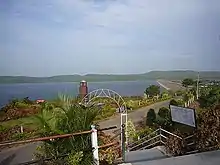
Starting at Sunkesula Dam on Tungabadra river Kurnool - Cuddapa Canal (K. C. Canal) flows through the district providing water to 40 km2 (15 sq mi) of cultivable land. The main source of drinking water to this district is Galeru Nagari Sujala Sravanthi Project Canal.
There is one major irrigation project on the river Penna at Mylavaram. There are 4 medium irrigation projects namely Lower Sagileru Project, Upper Sagileru Project, BrahmamSagar Project and Pulivendula Branch Canal.[34] These form several reservoirs such as Brahmamsagar Reservoir, Mylavaram Dam Reservoir, Annamayya Project reservoir and Gandikota Reservoir.[35]
Energy
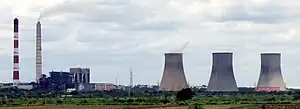
Rayalaseema Thermal Power Station with a capacity of 1650MW is one of the biggest coal based power plant. It is at Yerraguntla.
Industries
The district has 29 large and medium scale industries with an investment of Rs. 10,22,943 crores providing employment to 19,410. It also has 2335 small scale units employing 21,294 persons with an investment of Rs. 688.59 Cr.[34] Tummalapalle uranium mine was commissioned in 2012 to extract Uranium from ore.
Transport
Roadways
The district has 864.02 km (536.88 mi) of State Highway and 325.28 km (202.12 mi) of National Highway. The district is having 6174.69 KMs of BT roads 727.03 of CC road and 1458.48 KMs of Metal roads. [36] National Highway 40, National Highway 716 and National Highway 67 pass through the district.
Railways
The district has broad-gauge railway line of 195.13 km (121.25 mi). There are 14 railway stations covering 7 Mandals.[34] Kadapa, Yerraguntla Junction , Proddatur and Jammalamadugu are the major railway stations from the district under Guntakal railway division.
Airways
Kadapa Airport is a small airport located north west to Kadapa city. Tirupati Airport is the nearest bigger airport at a distance of 139 Kms from Kadapa city.
Education
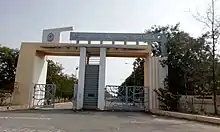
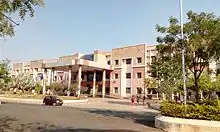
The district has 2001 Primary Schools, 468 Upper Primary Schools, 683 High Schools, 142 Junior Colleges, 48 Degree Colleges. It also has 120 Polytechnics, Engineering colleges and Govt. Aided Professional & Special Education Colleges. Rajiv Gandhi Institute of Medical Sciences (RIMS), one Dental college, one Homoeopathic Medical college, one Veterinary college and one IIIT centre at Rajiv Knowledge Valley, Idupulapaya of Vempalle mandal are also present in the district. [34]
JNTUA College of Engineering, Pulivendula is one of the government engineering colleges in the district. Yogi Vemana University offers P.G. courses for general education. CP Brown library in Kadapa is famous for its collection of manuscripts collected by CP Brown.[37]
Tourism

 Jamia Masjid and Madhavaraya Swamy Temple at Gandikota
Jamia Masjid and Madhavaraya Swamy Temple at Gandikota Chennakeshava temple at Pushpagiri
Chennakeshava temple at Pushpagiri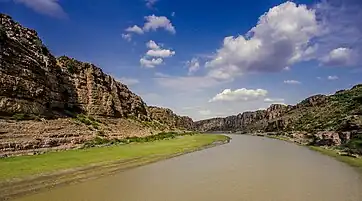 Gandikota gorge
Gandikota gorge
Siddavatam (Sidhout) at a distance of 25 Km Kadapa town is famous for its fort and temples. Matli Maharajas built the fort in A.D.1303. Hyder Ali destroyed it in 1770. The fort is spread over an area of 30 acres and has 17 bastions. It is called the southern gate way of Srisailam.[18] Brahmamgari Matham (B. Mattam), is the place where SreeVeerabrahmendra Swamy, a 17th century saint and clairvoyant entered Jeevasamadhi. The annual prayer festival is held for 6 days in the month of Vysakha.
Kodandarama Temple dedicated to the god Rama, is located in Vontimitta. The temple is built in Vijayanagara architectural style and is dated to the 16th century. This inspired Pothana to compose Andhra Maha Bhagavatham. It is located at a distance of 25 kilometres (16 mi) from Kadapa.[38] Some of the other tourist attractions are Chennakesava temple of Pushpagiri, Madhavaraya temple at Gandikota.
Gandikota gorge was formed in the Erramala range of hills. The river Penna flows in the gorge with a width of 100 m.
Notable people
Vemana was a philosopher and poet. His poems in simple language on social, moral, satirical and mystical themes are commonly recited by Telugu people. Potuluri Veerabrahmam, a 16th century saint and clairvoyant is known for his work Kalagnanam, a book of predictions written in Telugu.[39] Atukuri Molla was a poetess of 16th century. She wrote Molla Ramayanam in simple language. Charles Philip Brown served as district collector of Cuddapa during British rule. He took lot of interest in Telugu language, collected several manuscripts, published Vemana poems. Y. S. Rajasekhara Reddy was born in Pulivendula. He rose to become chief minister of combined Andhra Pradesh. B. Padmanabham acted as a comedian in over 400 films spanning a career of over six decades was born in Pulivendula.
References
- CPO 2022, p. VI.
- "New 'AP 39' code to register vehicles in Andhra Pradesh launched". The New Indian Express. Vijayawada. 31 January 2019. Archived from the original on 28 July 2019. Retrieved 9 June 2019.
- "YSR District". Kadapa district. Retrieved 10 May 2023.
- "District Census Hand Book –" (PDF). Census of India. Registrar General and Census Commissioner of India. Retrieved 11 April 2023.: 2
- "Six districts in Andhra reel under drinking water crisis". The New Indian Express. Vijayawada. 13 May 2019. Retrieved 14 June 2019.
- "Ex-Andhra Pradesh CM YSR's native district Kadapa to be named after him". The Times of India. 18 June 2010. Archived from the original on 21 February 2020. Retrieved 1 May 2021.
- CPO 2022, p. III.
- Thapar, B.K., ed. (1980). Indian Archaeology 1976–77–A Review (PDF). New Delhi: Archaeological Survey of India, Government of India. Archived from the original (PDF) on 8 May 2012.
- Murty, M. L. K. (2003). Comprehensive History and Culture of Andhra Pradesh: Pre- and protohistoric ... ISBN 9788125024750.
- Subramanyam, M.V. (25 July 2012). "Second largest rock art painting site explored". The Hindu. Chennai, India.
- Lakshmi, V. Swarajya (1982). A Descriptive Grammar of Cuddapah Dialect. Telugu Akademi. p. 2.
- "Archaeological Survey of India". ap.nic.in. Archived from the original on 4 March 2016. Retrieved 14 May 2013.
- "Mysterious cases of Hindu temples that will shock you". Speakingtree.in. 18 January 2016. Retrieved 10 May 2023.
- CPO 2022, p. IV.
- "The Career(s) and Memory of Neknam Khan in Seventeenth-Century Deccan". researchgate.net. 1 January 2014. Retrieved 10 May 2023.
- The Imperial Gazetteer of India, Volume 7. Oxford: Clarendon Press. 1908. pp. 158–76.
- CPO 2022, p. V.
- "Siddavatam Fort". AP Tourism. Retrieved 10 May 2023.
- "District Census Hand Book – YSR Kadapa" (PDF). Census of India. Registrar General and Census Commissioner of India.
- "Economy of Kadapa District". Andhra Pradesh Economic Development Board. Retrieved 25 April 2017.
- CPO 2022, p. VIII-IX.
- CPO 2022, p. VI-VII.
- CPO 2022, p. IX.
- CPO 2022, p. X.
- "Tummalapalle uranium mill to start operation by March 2011". Article from the Times of India. WISE Uranium Project. 24 October 2010. Retrieved 19 July 2011.
- "India: 'Massive' uranium find in Andhra Pradesh". BBC News – South Asia. BBC. 19 July 2011. Retrieved 19 July 2011.
- "Population by Religion - Andhra Pradesh". censusindia.gov.in. Registrar General and Census Commissioner of India. 2011.
- CPO 2022, p. XVIII.
- "Table C-16 Population by Mother Tongue: Andhra Pradesh". Census of India. Registrar General and Census Commissioner of India.
- CPO 2022, p. XXII.
- "AP cabinet approves two new revenue divisions". Deccan Chronicle. 7 April 2022. Retrieved 3 May 2022.
- CPO 2022, p. XXIII.
- "District-wise Assembly-Constituencies". ceoandhra.nic.in.
- CPO 2022, p. XI.
- "Krishna water released into Gandikota reservoir". The Hindu. Retrieved 19 March 2017.
- CPO 2022, p. XI-XII.
- "CP Brown Library in Kadapa, a treasure trove for researchers in various fields". The New Indian Express. 19 October 2020. Retrieved 10 May 2023.
- CPO 2022, p. XII-XIV.
- Proceedings of the Andhra Pradesh Oriental Conference, First Session, Andhra Saraswatha Parishat, Hyderabad, May 1977. The Conference. 1979. p. 131.
Kalagnana is a special type of discipline very popular in Andhra Desa because of the famous Kalagnanam of Sri Potuluri Veerabrahmendhra swami written in Telugu. It forecasts many incidents which are proved to be correct by the posterity.
Bibliography
- CPO (2022). District Hand Book of Statistics – 2020 : YSR district (PDF). Retrieved 11 April 2023.